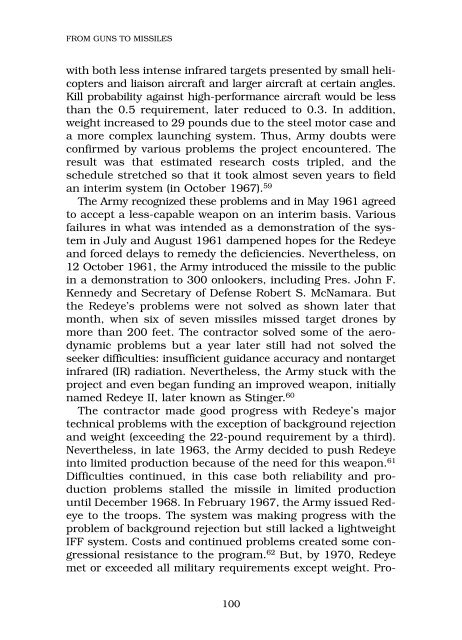Archie to SAM: A Short Operational History of Ground-Based Air ...
Archie to SAM: A Short Operational History of Ground-Based Air ...
Archie to SAM: A Short Operational History of Ground-Based Air ...
Create successful ePaper yourself
Turn your PDF publications into a flip-book with our unique Google optimized e-Paper software.
FROM GUNS TO MISSILES<br />
with both less intense infrared targets presented by small helicopters<br />
and liaison aircraft and larger aircraft at certain angles.<br />
Kill probability against high-performance aircraft would be less<br />
than the 0.5 requirement, later reduced <strong>to</strong> 0.3. In addition,<br />
weight increased <strong>to</strong> 29 pounds due <strong>to</strong> the steel mo<strong>to</strong>r case and<br />
a more complex launching system. Thus, Army doubts were<br />
confirmed by various problems the project encountered. The<br />
result was that estimated research costs tripled, and the<br />
schedule stretched so that it <strong>to</strong>ok almost seven years <strong>to</strong> field<br />
an interim system (in Oc<strong>to</strong>ber 1967). 59<br />
The Army recognized these problems and in May 1961 agreed<br />
<strong>to</strong> accept a less-capable weapon on an interim basis. Various<br />
failures in what was intended as a demonstration <strong>of</strong> the system<br />
in July and August 1961 dampened hopes for the Redeye<br />
and forced delays <strong>to</strong> remedy the deficiencies. Nevertheless, on<br />
12 Oc<strong>to</strong>ber 1961, the Army introduced the missile <strong>to</strong> the public<br />
in a demonstration <strong>to</strong> 300 onlookers, including Pres. John F.<br />
Kennedy and Secretary <strong>of</strong> Defense Robert S. McNamara. But<br />
the Redeye’s problems were not solved as shown later that<br />
month, when six <strong>of</strong> seven missiles missed target drones by<br />
more than 200 feet. The contrac<strong>to</strong>r solved some <strong>of</strong> the aerodynamic<br />
problems but a year later still had not solved the<br />
seeker difficulties: insufficient guidance accuracy and nontarget<br />
infrared (IR) radiation. Nevertheless, the Army stuck with the<br />
project and even began funding an improved weapon, initially<br />
named Redeye II, later known as Stinger. 60<br />
The contrac<strong>to</strong>r made good progress with Redeye’s major<br />
technical problems with the exception <strong>of</strong> background rejection<br />
and weight (exceeding the 22-pound requirement by a third).<br />
Nevertheless, in late 1963, the Army decided <strong>to</strong> push Redeye<br />
in<strong>to</strong> limited production because <strong>of</strong> the need for this weapon. 61<br />
Difficulties continued, in this case both reliability and production<br />
problems stalled the missile in limited production<br />
until December 1968. In February 1967, the Army issued Redeye<br />
<strong>to</strong> the troops. The system was making progress with the<br />
problem <strong>of</strong> background rejection but still lacked a lightweight<br />
IFF system. Costs and continued problems created some congressional<br />
resistance <strong>to</strong> the program. 62 But, by 1970, Redeye<br />
met or exceeded all military requirements except weight. Pro-<br />
100
















